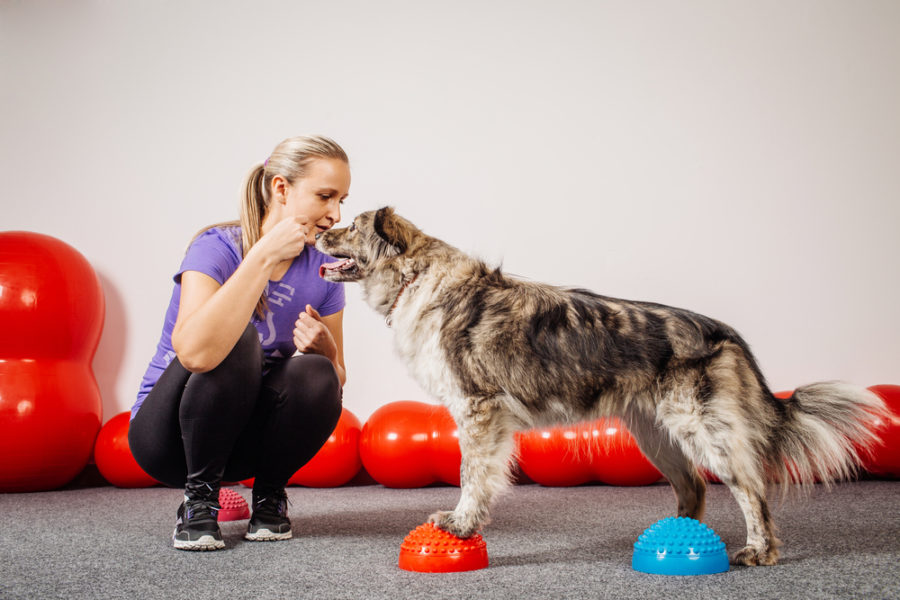A primary concern for canine athletes is the risk of injury. A conditioning program tailored to your individual dog, and the sport he’s involved in, will help prevent damage to his muscles and joints.
Legions of dogs are forsaking the couch potato lifestyle to become athletes. Canine sports abound these days, and range from agility and disc dog to dock diving, hiking and many more. There’s something to suit any breed or size of dog, and because it’s such a great way for both canines and humans to stay fit while having fun together, more and more people are getting their dogs involved in athletic activities. These dogs reap a lot of benefits from all that physical exercise, but there is a downside – they’re more likely to get injured than their less active fellows. You can help your canine athlete avoid being sidelined from the sport he loves by putting him on an individualized conditioning regimen.
Such a program includes general basic conditioning, exercises to rehabilitate any weaknesses and sports-specific exercises. “The number of injuries athletic dogs incur can be reduced by at least 50%, if not more, if the dogs are on an appropriate conditioning program,” says Dr. Debbie Gross Torraca, a certified canine rehabilitation therapist.
Start with basic conditioning
All athletic dogs need strong cores to protect their spines.
- One good core exercise, according to certified canine rehab therapist, Sasha Foster, is to have your dog stand on the floor and move her head up, down and to each side. When your dog can do 15 reps with good form, repeat the exercise on an unstable surface such as a cushion or exercise peanut.
- Other core-strengthening exercises include sit-to-stands on an unstable surface, and walking backwards.
- Canine athletes also need baseline aerobic/endurance conditioning, which can be accomplished with daily 30-minute walks, says Sasha.
- In addition, sports dogs must have proper warm-ups and cool-downs, according to Debbie. For warm-ups, leisurely walk your dog for five minutes; raise his heart rate with a fast walk or slow jog for the next five minutes; then do active stretching exercises (playing tug or reaching for a treat) along with activities he’ll perform in his sport for another five minutes.
- For cool-downs, fast walk your dog for five minutes, slow walk him for five minutes, and end with active stretching.
Conditioning for different canine sports
1. Agility, fly ball, and disc dog
Agility, fly ball and disc dog all stress a dog’s spine. They also require strong back legs and hips, flexibility and balance. Two good exercises for your dog’s rear quarters are sit-to-stands and sidestepping (place your dog’s front paws on a disc, then have him step around it). Fly ball dogs also need strong wrists. For this, place your dog’s front paws on a balance disc, and have him hold the position for 30 seconds.
For improving your dog’s balance, have him stand on a Bosu ball or other unstable surface. To increase the intensity, gently push the surface from side to side as well as up and down.
For endurance, agility dogs should practice three- to four-minute fast runs that include jumping and other agility activities. Fly ball and disc dogs should practice sprinting short intense runs at full speed. You can include a hurdle or box turn at the end for fly ball dogs, or throw a disc for disc dogs.
Hiking and running
Because running and hiking are activities that come most naturally to dogs, you don’t need to do a lot of strengthening for these sports, says Sasha. However, you do want to ensure your dog can handle difficult terrain. Prepare him for demanding hikes with doggy pushups, which strengthen the muscles he uses when moving downhill. Have him stand normally, and use a lure to get him to place his nose near the floor in front of his paws, then lift it up. Build up to 25 reps with three-second holds. To increase the intensity, place your dog’s back paws on a box.
To build his stamina for hiking, start with easy hikes on flat terrain. Then increase the hike’s length or the terrain’s difficulty week by week, until she can handle challenging hikes.
For jogging, start running with your dog for 15 minutes a day for a couple of weeks, and slowly progress to 30- or 45-minute daily runs.
Water sports
Dogs that participate in water sports need strong cores, hips and back muscles as well as full range of motion in their muscles and joints. To prepare your dog for swimming and jumping in the water, have her do side steps (which will work her range of motion as well as build strength), sit-to-stands and pushups.
If your dog participates in a water sport that focuses on fetching, she needs to do sprints to increase stamina. If she swims beside you or a paddle board, she needs low-intensity long-distance endurance training. This can be done with walking, jogging or swimming.
Winter sports
Winter may seem a long way off, but it’s never too soon to start training if you want your dog to get involved in activities such as snowshoeing and skijoring. The training is similar to what you would do for hiking. Include doggy pushups, so your dog can handle challenging terrains. Because moving through snow is so physically demanding for dogs, it’s very important to start with very short sessions when winter does arrive, and slowly increase your dog’s time on the powder. Protect his paws with dog boots.
Your dog’s conditioning program should include regularly-scheduled time for sports-specific exercises, sports-specific endurance training, and any rehabilitative exercises she needs as well as time to practice her sport. By following this personalized conditioning plan, you give your dog the best opportunity to compete happily, and injury free, for years to come.
Before starting a sport, have your dog evaluated
Before you even involve your dog in a sport, get her evaluated by a sports medicine veterinarian. Such evaluations are important for both purebred dogs, who have genetic predispositions for certain injuries, and mixed rescue dogs, who may have experienced undiagnosed orthopedic issues early in life that can cause problems as they age.
By looking at your dog’s lineage (if known) and assessing her gait, range of motion, functional movement, and weaknesses (if any), the sports medicine veterinarian will determine whether a particular sport is appropriate for her. The veterinarian will also recommend remedial exercises specifically geared to your dog if she has a weakness that could lead to an injury.








